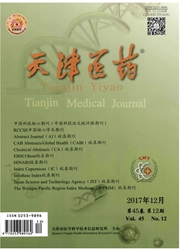

 中文摘要:
中文摘要:
目的:探讨肿瘤坏死因子超家族-15(TNFSFl5)在人卵巢癌标本中的表达及在小鼠体内TNFSFl5对卵巢癌血管生成及卵巢癌生长的影响。方法:应用免疫组化法检测正常组(12例)、卵巢癌组(94例)中TNFSF15的表达情况及微血管密度(MVD);雌性C57BL/6小鼠24只随机分为对照组、重组TNFSFl5注射组(实验组)、TNFSF15-shRNA处理组(A组)、shRNA一对照组(B组),每组6只,各组均采用皮下注射ID8细胞制备小鼠荷瘤模型,实验组采用腹腔注射重组TNFSFl5蛋白,A、B组采用TNFSF15-shRNA干扰其内源性表达的方法,通过检测小鼠肿瘤组织MVD值并测量肿瘤体积大小,观察其对小鼠卵巢癌细胞系ID8在小鼠C57BL/6体内血管生成及肿瘤生长的影响。结果:与正常卵巢组织相比,卵巢癌组织标本中TNFSF15表达显著降低(P〈0.01),且Ⅲ/Ⅳ期TNFSF15阳性表达率较I/Ⅱ期降低(P〈0.05);实验组较对照组小鼠肿瘤组织中MVD值降低且肿瘤体积减小(P〈0.05),而A组较B组MVD值升高且肿瘤体积增大(P〈0.05)。结论:卵巢癌微环境中TNFSF15表达下调或缺失是肿瘤新血管形成的前提条件。
 英文摘要:
英文摘要:
Objective: To study the expression of tumor necrosis factor superfamily-15 (TNFSF15) in human ovarian cancer specimens and the effects of TNFSF15 on tumor angiogenesis and growth in mice. Methods: The expression of TNFSFI5 and the value of microvesse] density (MVD) were detected by the method of immunohistochemistry in normal ovary group (n=12) and ovarian cancer group (n=94). Twenty-four female C57BId6 mice were randomly divided into 4 groups: control group, recombinant TNFSFI'5-treated group (experimental group), TNFSF15 shRNA-treated group (group A) and control-shRNA (group B). There were 6 mice for each group. The tumor-bearing mouse model was made by injecting subcutaneously ID8 cells into the flank of mia. The recombinant TNFSF15 was used to treat IDS-beafing C57BId6 mice via intraperitoneal injection. TNFSFI5-shRNA was used in group A and group B. The influences of TNFSF15 on tumor angiogenesis and growth were assessed by measuring MVD values and tumor volumes in mice. Results: Compared to the normal ovary tissues, the expression level of TNFSF15 decreased significantly in cancer specimens (P 〈 0.01), and the positive expression of TNFSF15 protein was lower in stage III/IV than that of stage I/II (P 〈 0.05). The values of MVD and the tumor volumes were decreased in experimental group than those of control group(P 〈 0.05). On the other hand, the MVD values and tumor volumes were higher in group A than those of group B(P 〈 0.05). Conclusion: The down regulation or absent of TNFSFI5 in ovarian cancer microenvironment is a pre-requisite for tumor neovaseularization.
 同期刊论文项目
同期刊论文项目
 同项目期刊论文
同项目期刊论文
 期刊信息
期刊信息
